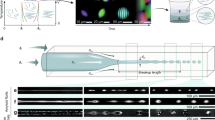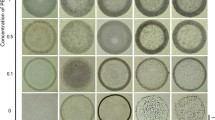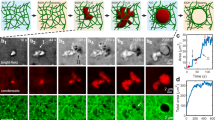Abstract
A novel methodology for the assembly of collagen fibrils in microliter drops is proposed. It consists in the gradual increase of pH by means of vapour diffusion coming from the decomposition of NH4HCO3 solutions. The pH increase rate as well as the final steady pH of solutions containing collagen can be adjusted by varying the concentration of NH4HCO3. Both parameters are of predominant importance in collagen fibrillogenesis. The effect of these parameters on the kinetic of the fibrillogenesis process and on the fibrils morphology was studied. We found that both the kinetic and the morphology are mainly driven by electrostatic interactions. A gradual increase of pH slows down the formation of collagen fibres and favours the lateral interaction between fibrils producing broader fibres. On the other hand, a rapid increase of pH reduces the lateral electrostatic interactions favouring the formation of thinner fibres. The formation of the D-band periodicity is also a pH-dependent process that occurs after fibrillogenesis when the most stable state of fibres formation has been reached.









Similar content being viewed by others
References
Patino MG, Neiders ME, Andreana S, Noble B, Cohen RE. Collagen: an overview. Implant Dent. 2002;11:280–5.
Di Lullo GA, Sweeney SM, Korkko J, Ala-Kokko L, San Antonio JD. Mapping the ligand-binding sites and disease-associated mutations on the most abundant protein in the human, type I collagen. J Biol Chem. 2002;277:4223–31.
Grinnell F. Fibroblast biology in three-dimensional collagen matrices. Trends Cell Biol. 2003;13:264–9.
Grinnell F. Fibroblast–collagen-matrix contraction: growth-factor signalling and mechanical loading. Trends Cell Biol. 2000;10:362–5.
Akiyama SK, Nagata K, Yamada KM. Cell surface receptors for extracellular matrix components. BBA Rev Biomembr. 1990;1031:91–110.
Salsas-Escat R, Stultz CM. The molecular mechanics of collagen degradation: implications for human disease. Exp Mech. 2009;49:65–77.
Tsamis A, Krawiec JT, Vorp DA. Elastin and collagen fibre microstructure of the human aorta in ageing and disease: a review. J R Soc Interface. 2013;10:20121004.
Kunicki TJ. The influence of platelet collagen receptor polymorphisms in hemostasis and thrombotic disease. Arterioscl Throm Vas. 2002;22:14–20.
Kadler KE. Learning how mutations in type I collagen genes cause connective tissue disease. Int J Exp Pathol. 1993;74:319.
Liu Y, Ren L, Long K, Wang L, Wang Y. Preparation and characterization of a novel tobramycin-containing antibacterial collagen film for corneal tissue engineering. Acta Biomater. 2014;10:289–99.
Ferreira AM, Gentile P, Chiono V, Ciardelli G. Collagen for bone tissue regeneration. Acta Biomater. 2012;8:3191–200.
Burg KJL, Porter S, Kellam JF. Biomaterial developments for bone tissue engineering. Biomaterials. 2000;21:2347–59.
McFadden TM, Duffy GP, Allen AB, Stevens HY, Schwarzmaier SM, Plesnila N, et al. The delayed addition of human mesenchymal stem cells to pre-formed endothelial cell networks results in functional vascularization of a collagen–glycosaminoglycan scaffold in vivo. Acta Biomater. 2013;9:9303–16.
Iafisco M, Quirici N, Foltran I, Rimondini L. Electrospun collagen mimicking the reconstituted extracellular matrix improves osteoblastic differentiation onto titanium surfaces. J Nanosci Nanotechnol. 2013;13:4720–6.
Mokrejs P, Langmaier F, Mladek M, Janacova D, Kolomaznik K, Vasek V. Extraction of collagen and gelatine from meat industry by-products for food and non food uses. Waste Manag Res. 2009;27:31–7.
Sanders H, Iafisco M, Pouget EM, Bomans PHH, Nudelman F, Falini G, et al. The binding of CNA35 contrast agents to collagen fibrils. Chem Commun. 2011;47:1503–5.
Alexander TN, Jamil A, Steven F, Rod JR. Cosmetic medicine: facial resurfacing and injectables. Plast Reconstr Surg. 2012;129:142e–53e.
Peng Y, Howell L, Stoichevska V, Werkmeister J, Dumsday G, Ramshaw J. Towards scalable production of a collagen-like protein from Streptococcus pyogenes for biomedical applications. Microb Cell Fact. 2012;11:146.
Kim BS, Choi JS, Kim JD, Yoon HI, Choi YC, Cho YW. Human collagen isolated from adipose tissue. Biotechnol Prog. 2012;28:973–80.
Liu W, Merrett K, Griffith M, Fagerholm P, Dravida S, Heyne B, et al. Recombinant human collagen for tissue engineered corneal substitutes. Biomaterials. 2008;29:1147–58.
Shoulders MD, Raines RT. Collagen structure and stability. Annu Rev Biochem. 2009;78:929.
Orgel JPRO, Miller A, Irving TC, Fischetti RF, Hammersley AP, Wess TJ. The in situ supermolecular structure of type I collagen. Structure. 2001;9:1061–9.
Hulmes DJ. Building collagen molecules, fibrils, and suprafibrillar structures. J Struct Biol. 2002;137:2–10.
Gómez-Morales J, Iafisco M, Delgado-López JM, Sarda S, Drouet C. Progress on the preparation of nanocrystalline apatites and surface characterization: overview of fundamental and applied aspects. Prog Cryst Growth Ch. 2013;59:1–46.
Kadler KE, Hojima Y, Prockop D. Assembly of collagen fibrils de novo by cleavage of the type I pC-collagen with procollagen C-proteinase. Assay of critical concentration demonstrates that collagen self-assembly is a classical example of an entropy-driven process. J Biol Chem. 1987;262:15696–701.
Cooper A. Thermodynamic studies of the assembly in vitro of native collagen fibrils. Biochem J. 1970;118:355–65.
Leikin S, Rau DC, Parsegian VA. Temperature-favoured assembly of collagen is driven by hydrophilic not hydrophobic interactions. Nat Struct Biol. 1995;2:205–10.
Harris JR, Soliakov A, Lewis RJ. In vitro fibrillogenesis of collagen type I in varying ionic and pH conditions. Micron. 2013;49:60–8.
Li Y, Asadi A, Monroe MR, Douglas EP. pH effects on collagen fibrillogenesis in vitro: electrostatic interactions and phosphate binding. Mater Sci Eng, C. 2009;29:1643–9.
Wood G, Keech M. The formation of fibrils from collagen solutions 1. The effect of experimental conditions: kinetic and electron-microscope studies. Biochem J. 1960;75:588.
Wood G. The formation of fibrils from collagen solutions. 3. Effect of chondroitin sulphate and some other naturally occurring polyanions on the rate of formation. Biochem J. 1960;75:605.
Wood G. The formation of fibrils from collagen solutions. 2. A mechanism for collagen-fibril formation. Biochem J. 1960;75:598.
Hayashi T, Nagai Y. Factors affecting the interactions of collagen molecules as observed by in vitro fibril formation. II. Effects of species and concentration of anions. J Biochem. 1973;74:253–62.
Silver FH. Type I collagen fibrillogenesis in vitro. Additional evidence for the assembly mechanism. J Biol Chem. 1981;256:4973–7.
Brennan M, Davison PF. Influence of the telopeptides on type I collagen fibrillogenesis. Biopolymers. 1981;20:2195–202.
Jiang F, Hörber H, Howard J, Müller DJ. Assembly of collagen into microribbons: effects of pH and electrolytes. J Struct Biol. 2004;148:268–78.
Cisneros DA, Hung C, Franz CM, Muller DJ. Observing growth steps of collagen self-assembly by time-lapse high-resolution atomic force microscopy. J Struct Biol. 2006;154:232–45.
Walton R, Brand D, Czernuszka J. Influence of telopeptides, fibrils and crosslinking on physicochemical properties of Type I collagen films. J Mater Sci Mater Med. 2010;21:451–61.
Iafisco M, Gómez-Morales J, Hernández-Hernández MA, García-Ruiz JM, Roveri N. Biomimetic carbonate-hydroxyapatite nanocrystals prepared by vapor diffusion. Adv Eng Mater. 2010;12:B218–23.
Ramírez-Rodríguez GB, Delgado-López JM, Gómez-Morales J. Evolution of calcium phosphate precipitation in hanging drop vapor diffusion by in situ Raman microspectroscopy. CrystEngComm. 2013;15:2206–12.
Gómez-Morales J, Delgado-López JM, Iafisco M, Hernández-Hernández A, Prat M. Amino acidic control of calcium phosphate precipitation by using the vapor diffusion method in microdroplets. Cryst Growth Des. 2011;11:4802–9.
Gómez-Morales J, Hernández-Hernandez A, Sazaki G, García-Ruiz JM. Nucleation and polymorphism of calcium carbonate by a vapor diffusion sitting drop crystallization technique. Cryst Growth Des. 2010;10:963–9.
Iafisco M, Delgado-López JM, Gómez-Morales J, Hernández-Hernández MA, Rodríguez-Ruiz I, Roveri N. Formation of calcium phosphates by vapour diffusion in highly concentrated ionic micro-droplets. Cryst Res Technol. 2011;46:841–6.
Hames BL. Gel electrophoresis of proteins: a practical approach. 3rd ed. Oxford: IRL Press; 1988.
Rodríguez-Ruiz I, Delgado-López JM, Durán-Olivencia MA, Iafisco M, Tampieri A, Colangelo D, et al. pH-responsive delivery of doxorubicin from citrate-apatite nanocrystals with tailored carbonate content. Langmuir. 2013;29:8213–21.
Falini G, Fermani S, Foresti E, Parma B, Rubini K, Sidoti MC, et al. Films of self-assembled purely helical type I collagen molecules. J Mater Chem. 2004;14:2297–302.
Muralidharan N, Jeya Shakila R, Sukumar D, Jeyasekaran G. Skin, bone and muscle collagen extraction from the trash fish, leather jacket (Odonus niger) and their characterization. J Food Sci Technol. 2013;50:1106–13.
Hattori S, Adachi E, Ebihara T, Shirai T, Someki I, Irie S. Alkali-treated collagen retained the triple helical conformation and the ligand activity for the cell adhesion via α2β1 integrin. J Biochem. 1999;125:676–84.
Li Y, Douglas EP. Effects of various salts on structural polymorphism of reconstituted type I collagen fibrils. Colloids Surf B. 2013;112:42–50.
Gelman RA, Poppke DC, Piez KA. Collagen fibril formation in vitro. The role of the nonhelical terminal regions. J Biol Chem. 1979;254:11741–5.
Weiner S, Wagner HD. The material bone: structure-mechanical function relations. Annu Rev Mater Sci. 1998;28:271–98.
Acknowledgments
This work has been carried out within the frameworks of the projects from Spanish MINECO co-funded with FEDER (Projects MAT2011-28543 and Factoría de Cristalización, Consolider-Ingenio 2010), Junta de Andalucía (RMN 1344) and the Master in Crystallography and Crystallization (CSIC-UIMP). JMDL also acknowledges to the Spanish Servicio Público de Empleo Estatal (SEPE) for the funding during the writing of the manuscript. MI and AT would like to acknowledge the European projects SMILEY (FP7-NMP-2012-SMALL-6-310637) and OPHIS (FP7-NMP-2009-SMALL-3-246373).
Author information
Authors and Affiliations
Corresponding author
Rights and permissions
About this article
Cite this article
Ramírez-Rodríguez, G.B., Iafisco, M., Tampieri, A. et al. pH-responsive collagen fibrillogenesis in confined droplets induced by vapour diffusion. J Mater Sci: Mater Med 25, 2305–2312 (2014). https://doi.org/10.1007/s10856-014-5189-1
Received:
Accepted:
Published:
Issue Date:
DOI: https://doi.org/10.1007/s10856-014-5189-1




